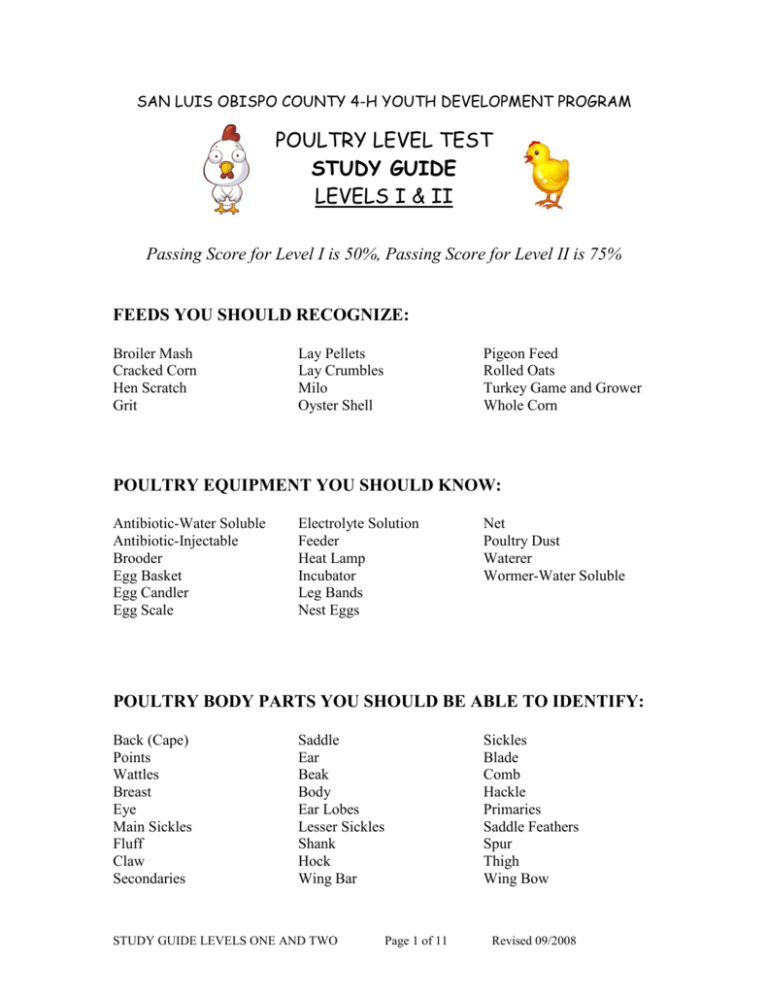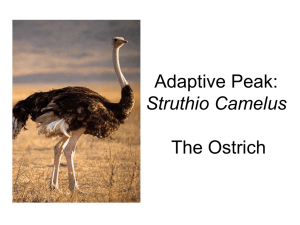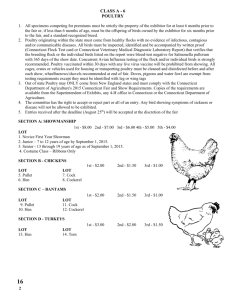Poultry Study Guide Level One and Two
advertisement

SAN LUIS OBISPO COUNTY 4-H YOUTH DEVELOPMENT PROGRAM POULTRY LEVEL TEST STUDY GUIDE LEVELS I & II Passing Score for Level I is 50%, Passing Score for Level II is 75% FEEDS YOU SHOULD RECOGNIZE: Broiler Mash Cracked Corn Hen Scratch Grit Lay Pellets Lay Crumbles Milo Oyster Shell Pigeon Feed Rolled Oats Turkey Game and Grower Whole Corn POULTRY EQUIPMENT YOU SHOULD KNOW: Antibiotic-Water Soluble Antibiotic-Injectable Brooder Egg Basket Egg Candler Egg Scale Electrolyte Solution Feeder Heat Lamp Incubator Leg Bands Nest Eggs Net Poultry Dust Waterer Wormer-Water Soluble POULTRY BODY PARTS YOU SHOULD BE ABLE TO IDENTIFY: Back (Cape) Points Wattles Breast Eye Main Sickles Fluff Claw Secondaries Saddle Ear Beak Body Ear Lobes Lesser Sickles Shank Hock Wing Bar STUDY GUIDE LEVELS ONE AND TWO Sickles Blade Comb Hackle Primaries Saddle Feathers Spur Thigh Wing Bow Page 1 of 11 Revised 09/2008 BE ABLE TO IDENTIFY THE FOLLOWING TYPES OF STANDARD MALE COMBS (Level I & II) Single Comb Rose Comb Pea Comb Cushion Comb Buttercup Comb Strawberry Comb V- Comb (Sultans) BE ABLE TO IDENTIFY THE PARTS OF THE MALE CHICKEN (Level I) STUDY GUIDE LEVELS ONE AND TWO Page 2 of 11 Revised 09/2008 BE ABLE TO IDENTIFY THE PARTS OF THE FEATHER (Level I) Shaft Web Fluff Quill BE ABLE TO IDENTIFY THE PARTS OF THE EGG (Level II) 1. 2. 3. 4. 5. 6. 7. Cuticle Shell Yolk Chalazae Germinal Disc Albumen Air Cell STUDY GUIDE LEVELS ONE AND TWO Page 3 of 11 Revised 09/2008 BE ABLE TO IDENTIFY THE INTERNAL ORGANS (Level II) Lung Gizzard Crop Kidney Liver Esophagus Intestine Heart Trachea STUDY GUIDE LEVELS ONE AND TWO Page 4 of 11 Revised 09/2008 BE ABLE TO IDENTIFY THE PARTS OF THE WING (Level II) 1. 2. 3. 4. 5. 6. 7. Front Bow Bar Secondary Primaries Primary Coverts Wing Shoulder STUDY GUIDE LEVELS ONE AND TWO Page 5 of 11 Revised 09/2008 TERMS TO KNOW A.O.S.B.: All other standard breeds. A.O.C.C.L.: All other combs clean legged. BACK: The top section of the body from the base of the neck to the base of the tail, including the cape and saddle. BANTAM: A diminutive fowl, some being distinct breeds, others being miniature of a large breed. BEAK: The horny formation projecting from the front of the head of chickens, pigeons and turkeys. BILL: The horny formation projecting from the front of the head of waterfowl. BLADE: The lower unserrated part of a single comb. BODY: That portion which contains the trunk of the bird. The part exclusive of the head, neck, wings, tail, thighs, shanks and toes. BRASSINESS: A term descriptive of a light yellowish metallic cast commonly found in the plumage of white and part-white varieties. May be hereditary or affected by exposure to sun and certain items in the diets (such as too much corn). BREED: An established group of individuals possessing similar characteristics, and when mated together produce offspring with those same characteristics. A breed may include a number of varieties. CANDLING: A process of shining a light behind eggs to check for cracks, infertile or fertile eggs. This process is done after the first (10) days of incubation. DON’T KEEP EGGS FROM INCUBATOR MORE THAN 10 MINUTES. CAPON: A term used to designate a castrated male fowl. COCK: A male fowl one year old or more (rooster). COCKEREL: A male fowl less than one year old. COMB: The fleshy protuberance on top of the head of a fowl, larger in the male than the female. The comb shapes vary by breed. CROP: The enlarged part of the gullet lying at the front of the body at the base of the neck. An outpocketing of the esophagus. Food is stored here and during storage the food is softened. NO DIGESTION TAKES PLACE IN THE CROP. STUDY GUIDE LEVELS ONE AND TWO Page 6 of 11 Revised 09/2008 DEFECT: Anything short of perfection. DEWLAP: A pendulous growth of skin under the rear of the beak or bill and extending onto the throat area. Examples: African Geese, Brahma Females, Turkeys. DISQUALIFICATION: A term applied to a deformity or a defect, sufficiently serious to debar a fowl from an award, usually inherited. DRAKE: A male duck. DUBBED-DUBBING: A term used to describe the close trimming of the comb, wattles and ear lobes of the male Modern Game, Large and Bantam; and the Old English Game male, large and bantam. Cocks not dubbed: A disqualification in the shows. Males 6 months and younger may be shown without being dubbed. DUCK: A species of waterfowl, including both sexes. FEATHER: One of the epidermal outgrowths, which collectively forms the external covering or plumage of a fowl. FOWL: A collective term applying to chickens, ducks, geese and turkeys – same as poultry. GANDER: A male specimen of domestic geese, adult if over one year of age. GOOSE: A female specimen of domestic geese, adult if over one year of age. HACKLE: The rear and the side neck plumage of a fowl. HEN: A female fowl. For exhibition purposes, a female chicken or turkey one year old or more. HORNY: Horn-like substance, such as the beak or bill, scales of leg, toenails and spurs; also the knob in geese. KEEL: In chickens and turkeys, the lower median edge of the keel or breast bone or more specifically, that portion of the middle sternum that resembles the keel of a boat. PLUMAGE: The collective feather covering of the entire body of a fowl, including the head, neck, wings, tail and where specified for breed, the shanks and toes. POULT: The young of the domestic turkey before the sex can be determined. POULTRY: A general term applied to all domesticated fowl, including chickens, turkeys and waterfowl. STUDY GUIDE LEVELS ONE AND TWO Page 7 of 11 Revised 09/2008 PULLET: For exhibition purposes, a female fowl less than one year old. QUILL: The basal hollow and transparent horn like portion which attaches the feather to the fowl’s body. RCCL: Rose comb clean legged. SCCL: Single comb clean legged. SHAFT: The extension of the quill the entire length of a feather to which the barbs are attached. STUB: A short section of the stem of a feather sometimes with a few short barbs attached thereto; a disqualification when found on shanks, or on or between the toes of clean legged breeds. TOM: A male of domestic turkeys. TRIO: In show room pariance, a cock, and two hens, or a cockerel and two pullets of the same variety. UNDERCOLOR: The color of the lower or fluff portion of feathers, not visible when the feathers are in natural position. VARIETY: A sub-division of a breed. SEE BREED. STUDY GUIDE LEVELS ONE AND TWO Page 8 of 11 Revised 09/2008 IMPORTANT INFORMATION FOR YOU TO KNOW: The American Poultry Association issues a book called THE AMERICAN STANDARD OF PERFECTION. This book contains a complete description of each of the more than 300 recognized breeds and varieties of poultry. Such things as size, color, and physical features are described and illustrated in detail. There are 14 “standard” breeds of ducks that are divided into the four classes: Heavy Weight, Medium Weight, Light Weight and Bantam. There are 11 “standard” breeds of geese that are divided into three classes: Heavy Weight, Medium Weight and Light Weight. There are 6 classes of “large” chickens: American, Asiatic, English, Mediterranean, Continental, and All Other Standard Breeds. There are 5 classes of “bantam” chickens: Game Bantam, Single Comb Clean Legged, Rose Comb Clean Legged, All Other Combs-Clean Legged, and Feather Legged. Most breeds and varieties we know in the U.S. today were developed between 1875 and 1925. During that time period, the emphasis throughout the poultry world was developing and standardizing the breeds and varieties. Today, most poultry breeding focuses on the improvement of commercial traits for meat and eggs. The chicken is, by far, the most important bird to humans. There are basically two types of chickens in the commercial industry, broilers/fryers (poultry raised for meat) and layers (poultry raised for egg production). When considering which type of bird is right for you, first decide whether you want production birds or exhibition birds. If choosing birds for egg production, decide which color eggs you prefer. There is no nutritional difference between white, brown or colored eggs, but their shell color may influence the market price. If choosing exhibition birds, determine the availability of the breed as well as which breed is the right size and temperament for the exhibitor. The life of the chicken begins from a single cell. This cell has its beginning from the union of the male and female sex cell, in the process known as fertilization. In birds, fertilization occurs about 24 hours before the egg is laid. The egg takes approximately 24 hours from the time it is released from the ovary until it is laid by the hen. Incubation periods vary from chickens to ducks to geese. In general, the incubation period for chickens is 21 days. Most duck eggs take 28 days; Muscovy ducks take 35 days. Most geese eggs take 30 days to hatch, except for Canada and Egyptian geese, which take 35 days. STUDY GUIDE LEVELS ONE AND TWO Page 9 of 11 Revised 09/2008 When the chick begins to escape from the egg, it uses a small sharp horny structure located on the tip of its beak called an egg tooth. The egg tooth’s only purpose is to help the chick hatch from the egg. After a few days the egg tooth will fall off the bird’s beak. While the chick is forming inside the egg, it uses the yolk as its food source. Just prior to emerging from the shell the last of the yolk is absorbed into the chick’s abdomen. The yolk material weighs about one-sixth of the chick’s total weight. Newly hatched chicks can live on the unabsorbed yolk in their bodies for about 72 hours after they hatch if necessary. However, chicks with access to food and water will begin to eat and drink at less than one day of age. Brooding chicks require the correct temperature, light, bedding, water, feed and protection from drafts. Newly hatched chicks should be maintained in 90-95°F for the first week. The temperature is dropped by about 5°F per week until they are feathered and can be maintained in a normal room temperature, 60-70°F. They must have a light source, which is not too bright, as ‘picking’ will occur. If the light source is too dull, the chicks will tend to ‘pile’ on each other, which can cause suffocation of the chicks on the bottom. Fresh water is necessary as well as a chick starter food, which is higher in protein (about 21%) than the adult birds require (16-18%). The well-managed laying flock should start laying eggs at 22-24 weeks of age. The length of their laying cycle is normally 12 to 14 months. Waterfowl normally start laying eggs in late February. Egg production usually peaks in April and declines rapidly during June. Birds used for exhibition should always be clean, healthy and as near to complete feather as possible. They should be at least 4 months old at show time, 6-7 months is preferable. In contrast, birds shown for meat production, are generally 6 to 10 weeks old. They tend to have incomplete feather at that time, and are shown in classes based on weight. Eggs are a wonderful source of food for human consumption. The white of the egg is the ‘albumin’. The fresher the egg, the clearer the albumin. As the egg ages, carbon dioxide is produced making the ‘white’ of the egg appear more cloudy. The yellow of the egg is the ‘yolk’. The intensity of the color of the yolk depends on the diet of the hen. The more xanthophylls, (yellow pigments in feeds) that the hen consumes, the brighter orange-yellow the yolk will appear. Feeds high in xanthophylls are corn and alfalfa meal. Marigold flowers are extremely high in xanthophylls and may be fed to enhance the color of the yolk. Remember: Raw eggs that are contaminated with Salmonella, a bacteria that can cause outbreaks of food illness. Salmonella can be transmitted from infected laying hens directly into the interior of the eggs before the shells are formed. ALWAYS cook eggs thoroughly. Chicken should be cooked thoroughly also, to kill this same bacteria. STUDY GUIDE LEVELS ONE AND TWO Page 10 of 11 Revised 09/2008 There are twelve (12) parts to the digestive tract of a bird: Mouth (beak), Cranial Esophagus, Crop, Caudal Esophagus, Proventriculus (or true stomach), Ventriculus (gizzard), Duodenum, Pancreas, Small Intestine, Ceca, Large Intestine and Cloaca. In the digestive tract, the ventriculus (gizzard) is the organ located between the proventriculus (true stomach) and the intestine. The gizzard grinds the food of the chicken, it serves as the “chicken’s teeth”. The crop is an outpocketing of the esophagus. Food is stored here and during storage, the food is softened. NO DIGESTION TAKES PLACE IN THE CROP. Most digestion takes place in the ventriculus (gizzard). Most absorption of the nutrients from the food eaten by birds takes place in the intestines. For waterfowl and chickens alike, PARASITES, such as mites and lice are always a potential problem. A good plan is to dust each bird on the first day of every month with a good poultry dust. Sprinkle some powder in the nests and on the roost areas as well. Always dust before a poultry show and check your birds after the show. If your bird shows signs of infestation of parasites it will be disqualified at the show. Examine your bird after the show as your bird may be exposed to parasites while at the exhibition. Scaly leg is a common problem in birds as well. It is characterized by rough scales on the bird’s legs and feet. Scaly leg caused by a small mite that lives under the scales on a bird’s shanks and toes. Applying petroleum jelly to the legs best treats it. This suffocates the microscopic mites. Birds can be infested with intestinal worms. This can be treated by adding ‘piperazine preparations’ to the birds’ water as described on the label of the worming medications. Remember: Don’t take your birds to a show if they are acting sickly. You can infect the other birds and make your bird more ill. If you get to a show and your bird starts to act sick, take him from the show area and keep him away from the others. The most common type of illnesses in poultry are respiratory diseases. Most of these can be treated with antibiotics. However, you must try and identify which disease your bird has in order to determine the right medication with to treat. You may contact a reputable breeder, veterinarian or agricultural expert with the symptoms of your sick bird to determine what disease and what treatment is the best for the bird. STUDY GUIDE LEVELS ONE AND TWO Page 11 of 11 Revised 09/2008




